Check out my custom vibration dampener
Wilson Clash 100
In-depth Review & Playtest + Video
We hope you love this article. Just so you know, TennisCompanion may collect a small share of sales from the links on this page to help keep this site running. Learn more.
One of the most highly anticipated tennis racquets in recent years, the Wilson Clash, is a refreshing take on racquet design and one of my picks for the best tennis racquets in 2022.
Offering an innovative design that blends power and control to suit a wide range of players while delivering exceptional comfort, the Clash is a unique racquet that’s found a deserved level of success in its first edition.
In this guide, I dive deep to review the Wilson Clash, put it through the paces on-court, and share my experience to help players learn more about the racquet and determine whether it’s a good fit.
| Wilson Clash Models |
| Wilson Clash 100 |
| Wilson Clash 100 Pro |
| Wilson Clash 100L |
| Wilson Clash 100UL |
| Wilson Clash 98 |
| Wilson Clash 108 |
As a quick heads up, Wilson released the second generation of Clash racquets in February of 2022.
While you’re here, you may want to check out my reviews on the latest models, including the Wilson Clash 98 v2, Clash 100 v2, Clash 100 Pro v2, and Clash 108 v2.
Article Contents
Click below to jump to a section
Tap below to jump to a section
Video Review & Playtest
About the Wilson Clash
Specs & Technologies
Wilson Clash Models
Color & Aesthetics
Players Endorsing
Strings & Tension
Review & Playtest Notes
Summary & Takeaways
New to TennisCompanion?
Create a free account and explore my latest videos below
Wilson Clash 100 Video Review & Playtest
If you’re in the market for a new racquet and trying to decide whether the Wilson Clash is a good fit, then this video is for you.
Learn all about the specs and technologies with helpful visuals, gain insight into my experience on how the racquet performs, and see the racquet in action during my on-court playtest.
I cover a lot in this video, so if you’d like to skip around to sections that are most relevant for you, check out the timestamps below.
Intro
0:20: Intro
Specs
0:33: Spec Start
0:54: Length, Head Size, String Pattern
1:02: Weight
1:17: Balance
1:27: Swingweight
1:31: Stiffness
1:41: Beam
Technologies
1:54: Technologies Start
2:20: Free Flex
2:38: Stable Smart
2:47: Parallel Drilling
Aesthetics
3:00: Aesthetics Start
Strings
3:18: Recommended Tension Range
3:23: Playtest String Setup
3:50: General String Notes
Playtest
4:02: Playtest Start
4:21: Playtest Notes
4:28: Groundstrokes
5:01: Volleys
5:27: Serves
5:46: Returns
Summary
6:04: Summary Start
6:43: Wrapping Up
Of course, this guide serves as an excellent companion to the video and is jam-packed with extra information not found in the video. Enjoy!
About the Wilson Clash

Released in February of 2019, the Clash was a few years in the making, with Wilson digging deep to come up with something radically different.
Wilson’s Global Product Line Manager for Performance Racquets & Bags, Michael Schaeffer, sums it up nicely:
“Traditionally, when players are choosing a racquet, you’ve always had to make a decision. Do I want a flexible racquet that provides control or a stiff racquet that provides power? And that’s really where the idea for the name Clash came, taking two things that people didn’t think were possible and merging it together for this collision.”
It sounds like a lofty goal from the sidelines. However, the resulting specs tell a unique story with the racquet boasting one of the lowest stiffness or RA ratings on the market at 55, while maintaining excellent stability.
According to Bill Severa, Global Director for Advanced Innovation at Wilson Racquet Sports:
“The concept for Clash came from three ideas that didn’t work on their own, but when we merged them together, they created an incredible racquet.”
There’s no doubt, the first generation of the Wilson Clash made for an exciting release, and its subsequent success among tennis players tells an even more compelling story.
Wilson Clash vs. Blade, Pro Staff & Ultra
The Wilson Clash appears to have cemented its place in the Wilson performance racquet lineup, so let’s take a quick look at how it compares to a few of the other popular models.
Clash
The Wilson Clash seeks to blend the control of a flexible racquet and the power of a stiffer racquet without the sacrifice that typically occurs when you lean too heavily in either direction.
At the same time, you can argue it doesn’t benefit from the value that players can experience at both ends of the spectrum, but there’s absolutely a segment of players looking for something in-between.
In many ways, its performance characteristics sit between the Blade and the Ultra’s performance while offering a unique feel all its own.
Blade
The Wilson Blade is a classic feeling tennis racquet that all about control delivering less power, solid spin, and excellent comfort.
If you recall, the Wilson Clash looked to blend the control of a flexible racquet with the power of a stiff racquet, and the Blade happens to be on the control end of the spectrum.
Ultra
The Wilson Ultra is a stiffer and high-powered tennis racquet that caters to the modern game of tennis offering lots of topspin, more generous head sizes, and an easy to manage weight class.
In many ways, the Ultra falls on the opposite end of the spectrum from the Blade.
Pro Staff
Geared toward intermediate and advanced players, the Wilson Pro Staff is a long-standing line of tennis racquets that emphasizes mid-range power and topspin along with excellent feel.
These racquets are a bit stiffer and heavier than the Blade line with slightly smaller head sizes.
Wilson Clash Specs & Technologies
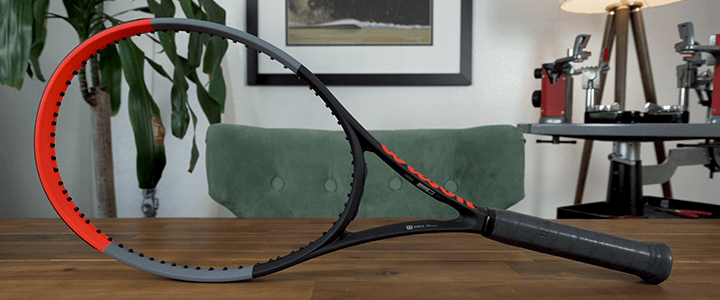
On the surface, the Wilson Clash looks for the most part, like any other racquet on the market.
However, to realize their vision for the Clash, the team at Wilson flexed their creative muscles to develop a few key technologies that support the racquet’s performance goals.
FreeFlex
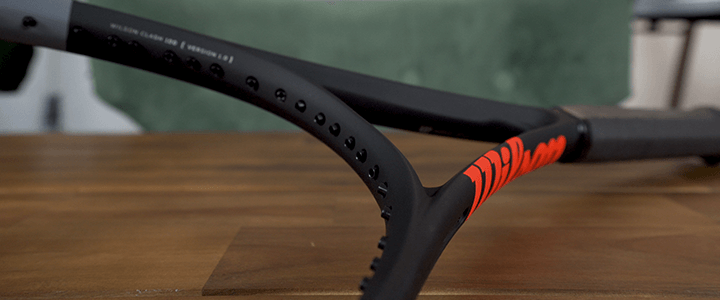
First up, you have what Wilson dubs Free Flex, which is proprietary carbon mapping that tailors the construction of the frame’s graphite to allow for greater horizontal and vertical flex.
As a racquet swings forward and comes in contact with the ball, it flexes horizontally, some flex more than others. There’s some degree of twisting that occurs too, which contributes to a frame’s stability.
However, Wilson was particularly interested in vertical flex when it came to the Clash to align with modern low to high swings that are common and help players hit with more topspin.
FreeFlex allows for maximum horizontal and vertical flex while maintaining torsional stability for control.
StableSmart
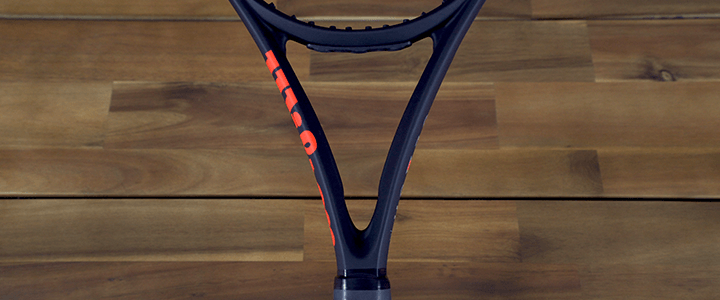
A flexible frame without stability doesn’t instill confidence when hitting, so Wilson introduces their StableSmart technology, which shows up as a unique geometric design of the racquet’s shaft.
As a result, the technology allows the frame to achieve flex without giving up power or becoming erratic.
Parallel Drilling
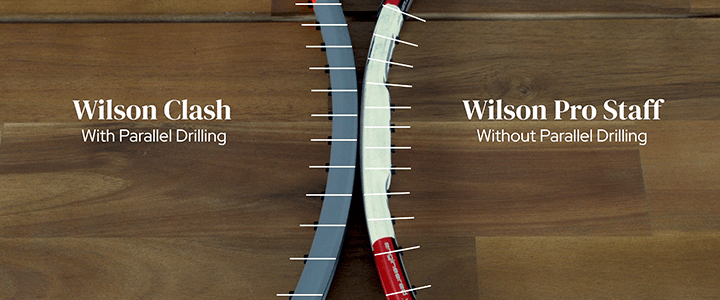
Last but not least, the Wilson Clash offers parallel drilling for select grommets throughout the frame.
The head of a racquet is oval, and holes are drilled through the edges to allow strings to pass through. Historically, manufacturers drilled these grommet holes at an angle consistent with the arch of a frame.
However, many of Wilson’s racquets, including the Wilson Clash, now drill many of the grommet holes through the racquet’s mid-section parallel from one side of the racquet to the other.
According to Wilson, the result is an increase in the size of the sweetspot, improved comfort, and better response when hitting.
Wilson Clash Specs
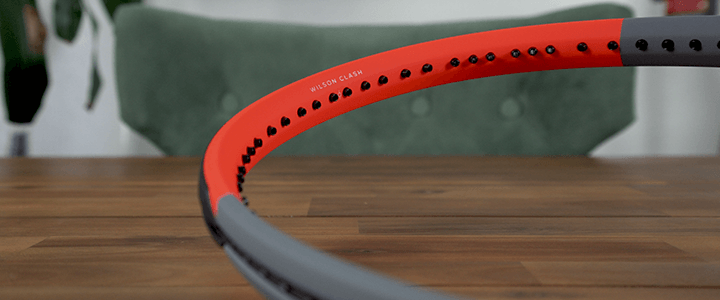
When reviewing different racquets, the specs can serve as a useful point of comparison, but nothing is better than demoing a racquet firsthand.
Here’s a look at the specs for the Wilson Clash 100.
| Spec | Measurement |
| Head Size | 100 in² / 645.16 cm² |
| Length | 27 in / 68.58c m |
| Strung Weight | 11.2 oz / 318 g |
| Unstrung Weight | 10.6 oz / 300 g |
| Balance | 4 pts HL / 33 cm |
| Unstrung Balance | 7 pts HL / 32 cm |
| Swingweight | 324 |
| Stiffness | 67 |
| Beam Width | 24.5 mm / 24.5 mm / 24.5 mm |
| Composition | Graphite |
| String Pattern | 16 Mains / 19 Crosses |
| String Tension | 50-59 pounds / 23-27 kg |
The Clash comes in your standard length of 27 inches and features a very reasonable 100 square inch head size with a 16×19 string pattern.
Wilson quotes the racquet weighs in at 10.4 ounces or 295g unstrung, but some variance is typical – as you can see, the frame that I purchased for the playtest is just shy of 10.3 ounces or 291 grams.
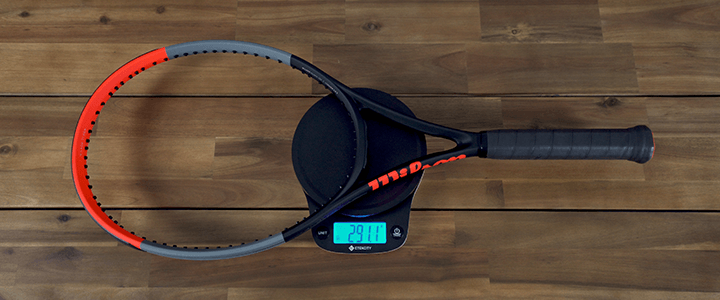
You can add 18 or so grams for the strung weight.
When it comes to the racquet’s balance, it’s 10 pts head light at 31 cm unstrung, which reduces to 7 pts head light at 32 cm with strings.
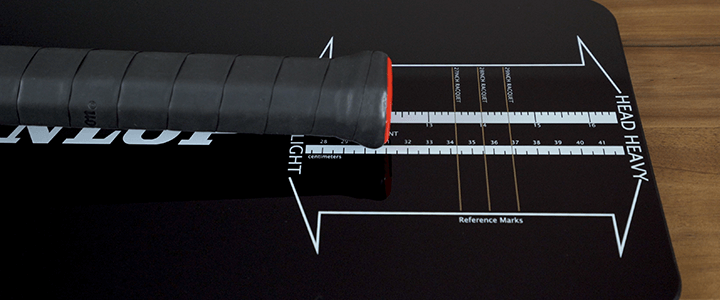
It’s swingweight is relatively low at only 312.
As far as flex goes, it’s unique and clocks in a super low stiffness or RA rating of 55 as one of the most flexible racquets on the market.
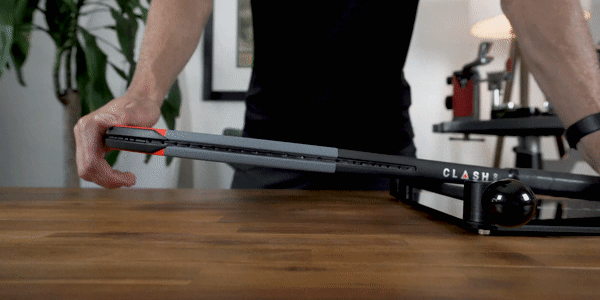
Last but not least, the Clash has a 24.5 mm beam all the way around.

Wilson Clash Models
Like many families of tennis racquets these days, you have more than one option when it comes to the Wilson Clash.
Within the Clash family of racquets, you have six different racquets to choose from – each with the same underlying tech that makes it a Clash, but with slightly different specs.
If you’re looking to buy the Wilson Clash, it’s good to be aware of the many options available and the differences between them, so in this section, I break down at a high level what to expect from each.
Wilson Clash 100
The Wilson Clash 100 is the flagship model and an ideal starting point for any player interested in this line of racquets, which I’ll use as a basis for comparing the rest of the models.
I purchased this racquet for my playtest.
Wilson Clash 100 Pro (previously Tour)
At 10.4 ounces (295g) unstrung, the standard Wilson Clash 100 above is a tad on the lighter side for many intermediate players. If you fall into that category, then the Pro (previously called the Tour) is a great option.
It’s roughly a half-ounce (15g) heavier than the standard model, so there’s a bit extra mass to help keep the racquet a bit more stable, but it’s also going to require a bit more of the player to swing it.
All in all, the Pro is still a reasonable weight for many players.
Wilson Clash 100L
Moving in the opposite direction, the Wilson Clash 100L is a half-ounce (15g) lighter than the standard model at 9.9 ounces or (280g).
As a result, it’s a great option for players that enjoy the Clash but need or prefer a slightly lower weight. Strong beginners moving toward the intermediate level may appreciate a racquet that’s a bit easier to swing.
Wilson Clash 100UL
If the Wilson Clash 100L isn’t light enough, you can drop down even further with the 100UL or ultralight version, which reduces a full ounce (30g) from the standard model to roughly 9.4 ounces (265g).
This version is easiest to maneuver and an excellent option for strong teenage players who are moving into full-size tennis racquets but need something that’s still easy to handle.
Wilson Clash 98
Intermediate to advanced players might love the feel of the Wilson Clash but have a desire less power, more control, and enhanced stability.
Enter the Clash 98. For this model, Wilson reduces the head size to 98 square inches and increases the weight over the standard model by 0.2 ounces (6g) to help deliver lower power, better control, and extra stability.
Wilson Clash 108
On the other end of the spectrum, the Wilson Clash 108 increases the head size substantially for those looking for the extra margin for error.
It’s the same weight as the standard Wilson Clash 100, but the 16×19 string pattern opens up even further for great topspin.
However, it takes things a step further by increasing the racquet’s length by a quarter-inch (.64cm) to deliver power with a bit more ease.
Color & Aesthetics

The Wilson Clash comes stock in a tri-color setup.
Through the shaft and lower portion of the racquet’s head, you’ll find a sleek velvet black. At three and nine at the sides of the racquet’s head, you’ll find Wilson’s proto grey and then a bright infrared at the top.
The racquet also features an infrared Wilson logo on one side of the racquet’s throat and a silver Clash logo on the opposite side.
Last but not least, the racquet comes with a black bumper guard and grommet setup and a black grip.
If, like me, red isn’t your favorite color, you can solve that if you head over to Wilson’s website to customize the paint job to your heart’s content.
It’s not inexpensive, and it will take 4-6 weeks for delivery, but it’s a fun option that’s worth noting.
Players Endorsing the Clash
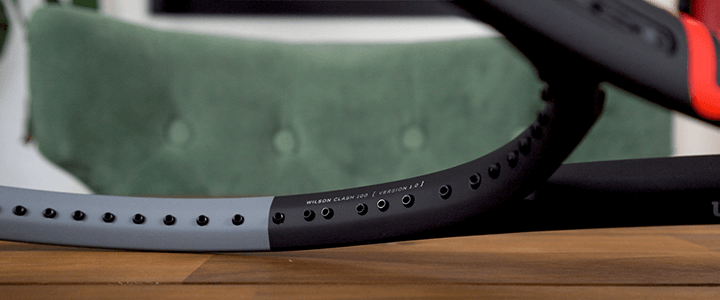
In the grand scheme of things, the Wilson Clash is still a newcomer to the market in its first generation, so we haven’t seen much adoption on the ATP or WTA pro tours.
Additionally, not much time has passed where younger players who have grown up with the racquet have emerged playing a high level of tennis. If we do see broader pro-level endorsement, it may be a while.
Despite that, current world #151 Nicole Gibbs on the WTA does endorse the Wilson Clash. Previously, she used the Wilson Blade, but after demoing the Wilson Clash in December of 2018, quickly realized that it was the ideal frame for her and made the switch for 2019.
Nicole suggested she was hitting a more consistent ball with greater depth and better control, so the switch was a natural decision.
Nicole Gibbs uses the standard Wilson Clash 100 with some customization to match her game.
Wilson Clash Strings & Tension
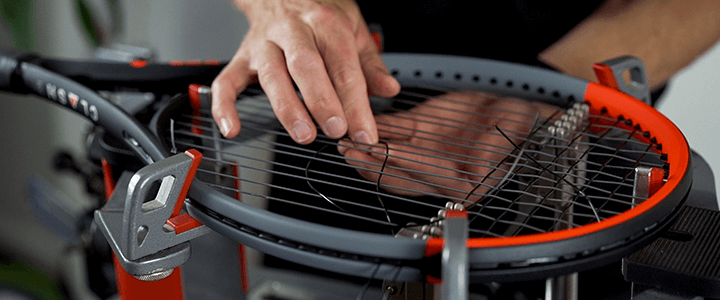
If you’re new to stringing the Wilson Clash, it’s good to know that the recommended tension range is 47 – 57 pounds (21-26kg).
For my playtest, I used a hybrid string setup.
In the mains, I strung with 1.25 mm (16L) gauge Luxilon Alu Power at 50 pounds (22.68 kg). I went with 1.30 mm (16) gauge Wilson NXT at 52 pounds (23.59 kg) for the crosses.
A lot of players with arm issues take a chance on this racquet for comfort, so I wanted to go with a string setup that would make sense for those users without giving up too much on the spin front.
Luxilon ALU Power is a stiffer polyester tennis string that’s durable and well-known for its excellent spin potential. Wilson NXT, on the other hand, is a softer multifilament that offers exceptional comfort and power.
Keep in mind that the mains in a hybrid string setup will dominate the overall feel, so you could flip my setup by stringing Wilson NXT in the mains and Luxiolon ALU Power in the crosses for a bit more comfort.
Of course, if comfort is a top priority, you might go with a full multifilament setup or a full poly setup for better durability and topspin.
Be sure to check out my picks for the best strings in 2020 for a few additional options worth considering for the Wilson Clash.
Wilson Clash Review & Playtest Notes

As I mentioned earlier, the specs and technology behind a racquet are interesting, and it’s helpful to understand the intention behind them.
However, what really matters is how a racquet feels when you hit the court. With this in mind, I put the Wilson Clash to the test over two-weeks to share my experience.
Below you’ll find a few notes that you might find useful when considering my thoughts and opinions.
| Main Strings | Luxilon ALU Power (1.25 mm) |
| Cross Strings | Wilson NXT (1.30 mm) |
| Mains Tension | 50 lbs / 22.68 kg |
| Crosses Tension | 52 lbs / 23.58 kg |
| Forehand Grip | Semi-Western |
| Backhand | Two-handed |
| Grip Size | #3 – 4 3/8 |
| Grip | Wilson Performance Pro |
| Overgrip | Wilson Pro |
| Weight | 165 lbs / 74.84 kg |
| Height | 6’0″ / 1.83m |
Furthermore, I’ve included ratings on various criteria below, which I explain in greater detail on the sections that follow.
Groundstrokes
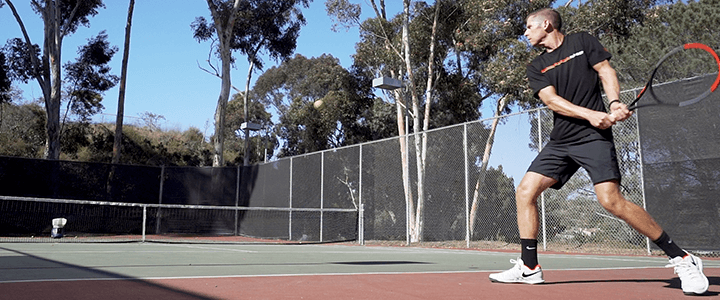
On groundstrokes, the Wilson Clash was fantastic, and the racquet delivered on the promise of a solid balance between control and power.
Without a doubt, you can feel the flex of the racquet, but the lively response and energy return on contact make it unique.
The ball really moves to deliver a level of power that’s counterintuitive to its feel, and pairs nicely with the open 16×19 string pattern for plenty of topspin without which would likely cause the power to be overbearing.
Despite its lower weight, I found the Clash to perform excellent hitting slice, and overall the comfort level from this frame is top-notch.
If I had to pick one area where this racquet shines, this would be it.
Volleys
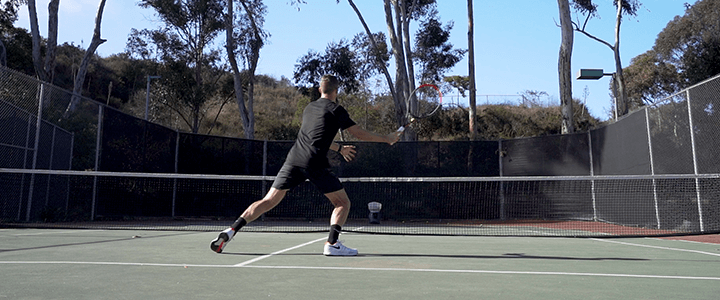
Up at the net, the Clash is easy to maneuver.
However, while its power is controllable from the baseline with the added benefit of topspin, it felt a bit too lively hitting volleys.
It’s the only area of the court where I felt I could have used a bit of extra tension or a full poly setup to help reign in power slightly.
I also think a bit more weight would go a long way with volleys to aid stability. I’d be inclined to add a few grams of weight at 10 and 2 o’clock on the racquet’s head, a simple customization that could go a long way.
With that said, the more time I spend with the racquet, the better it gets at net, which I think is partly to feeling out the unique response of the racquet, so I’m confident my feel here would continue to improve.
Serves

For serves, I thought the Wilson Clash was well-balanced.
It’s no slump when it comes to power, but it’s not entirely on par with racquets like the Wilson Ultra, Babolat Pure Aero, or Drive, and I think that’s perfectly fine.
You can argue it makes up for it by helping deliver more accurate placement, plenty of spin, and way more comfort, which is a tradeoff many players are likely happy to make.
Returns
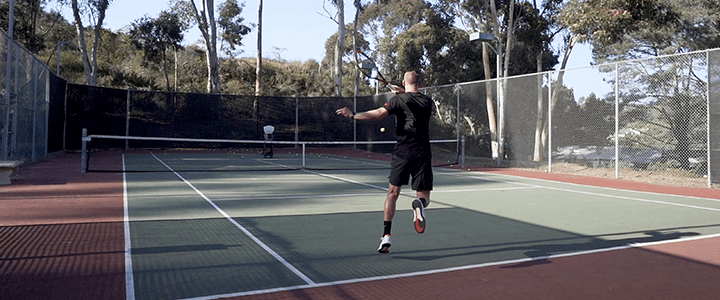
On returns, the racquet’s lower weight and head light balance make it easy to maneuver as expected, and although it can tend to get pushed around a bit on a heavier serve, it’s stable for its weight.
Overall, I was impressed with returns and felt confident in my approach with the frame’s spin-friendly characteristics helping keep the ball in play.
Again, adding a few grams of extra weight to the upper hoop of the racquet’s head might be worth considering to give the frame a bit more mass to handle bigger serves.
Summary & Takeaways
There’s no doubt the Wilson Clash is a uniquely distinct frame, and I applaud Wilson for their innovative approach to this racquet.
Although it does seem to strike a balance between control and power, I felt it skewed more toward power with reduced stiffness to improve comfort, which is where I think the frame finds a sweet spot. To be clear, the Wilson Clash is not a high-powered racquet, but if I had to pick a direction that it leans – power would be it.
Players who want respectable spin and power, but demand comfort should absolutely consider it, and I thought the hybrid string setup I chose was an excellent pair for this group.
All in all, I think the racquet has broad appeal and is a safe recommendation for a wide range of players. However, this frame will be less likely to satisfy upper level intermediate to advanced players who demand more control, stability, and greater feedback.
Why I Love It
- Balanced control and power
- Comfort
- Stability for its weight
- Great sound coming off the racquet
Tradeoffs
- Lower feel and response
- Mid-range performance characteristics. It’s not going to deliver the most spin, best control, or highest level of power, but it does all pretty darn well.
Strings
If you’re looking for a balanced string setup that pairs nicely with the characteristics of the frame, then a hybrid string setup like I used for my playtest is a great all-around option. Again, here’s what I had used:
- Mains: Luxilon ALU Power 1.25 at 50 lbs (22.68 kg)
- Crosses: Wilson NXT 1.30 at 52 lbs (23.59 kg)
I’ll be experimenting further with this setup myself and increasing the tension 1-2 pounds on the multifilament crosses.
However, if you’re coming to the Wilson Clash from a stiffer spin-friendly tennis racquet and previously used a full poly setup, I’d start there. The racquet’s low stiffness or RA rating of 55 is likely all you’ll need to get the comfort that you’re after without giving up too much on the spin front.
If you’re new to tennis and have no idea where to start, check out my guide on how to choose tennis strings to find an excellent starting point.
Bottom Line
If you’ve enjoyed higher power spin-friendly tennis racquets but struggled with the stiffness of these frames and discomfort, then the Wilson Clash is a worthy contender for your attention and worth a demo.
The Wilson Clash is also a safe bet for players who are new to tennis and not exactly sure where to start with their first racquet. It’s a well-rounded and user-friendly frame that would be excellent to learn the game.
On the other hand, if you’re looking for maximum performance on any single attribute, i.e., power, spin, control, feel, etc., you’re likely going to want to look elsewhere for a frame skews in one of those directions.
Wrapping Up
I’ve hit with the Wilson Clash in the past briefly and was excited to finally spend some more quality time with the racquet as part of an official review and playtest, and I hope you enjoy what I had to share.
If possible, I’d encourage you to demo the Wilson Clash to experience the frame and form your own opinions. The racquet won’t be for everyone, but if you’ve been on the fence, I think the racquet is worth checking out – even if only for the novelty factor.
If you have any questions or you’d like to share your experience with the Wilson Clash 100, I’d love to hear from you in the comments below.
Play Better Tennis
Improve your game alongside our community of tennis players
Why join?
Discussion Boards
Join the conversation with other members of the community.
5 Point Friday
Read our weekly recap of the 5 most interesting things we dig up in tennis.
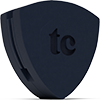

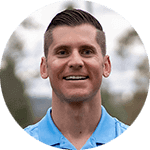

Leave a Reply
Want to join the discussion?Feel free to contribute!